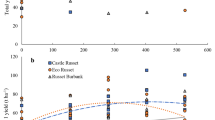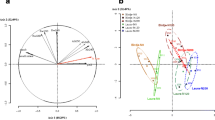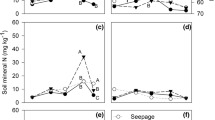Abstract
The response to nitrogen (N) rate for two potato (Solanum tuberosum L.) cultivars grown in a sub-tropical climate was evaluated during two spring seasons. Early-maturing tablestock potato cultivars, ‘Fabula’ and ‘Red LaSoda’, were grown using surface-drip irrigation. N fertilizer was applied through irrigation drip tape at 0, 112, 224, and 336 kg ha−1 of N. There was no difference of aboveground and tuber biomass accumulation between N fertilizer rates from 112 to 336 kg ha−1 of N during both growing seasons. Seasonal differences were observed in N recovery efficiency; in Season 1, apparent N recovery (ANR) was significantly higher for N rates of 112 and 224 kg ha−1 N for ‘Fabula’ and 112 kg ha−1 of N for ‘Red LaSoda’, respectively. In Season 2, there was no significant difference between ANR values among N rates between 112 and 336 kg ha−1 of N, for both cultivars. There was a significant interaction of N rate and growing season on total and marketable yields. In Season 1, average total and marketable yields for both cultivars increased from 9.8 Mg ha−1 with no N applied, to 25.8 Mg ha−1 with 224 kg ha−1 of N; no significant differences were observed at higher N rates. In Season 2, high early season rainfall likely depleted available soil N, resulting in decreased N recovery efficiency of plants and significantly lower yield compared to the previous season. N-fertilizer rates above 224 kg ha−1 of N did not increase total or marketable yields in both seasons. High rainfall events at the beginning of the Season 2 likely caused N stress and reduced tuber yields by 54% compared to the previous season. Results also highlighted the dominant effect of environmental conditions, particularly rainfall, on tuber yield and harvest quality response to N fertigation rate.
Resumen
Se evaluó la respuesta al nivel de nitrógeno (N) en dos variedades de papa (Solanum tuberosum L.) cultivadas en un clima subtropical durante dos ciclos de primavera. Se cultivaron las variedades precoces para mesa ‘Fabula’ y ‘Red LaSoda’, utilizando riego por goteo superficial. Se aplicó el fertilizante nitrogenado en la cinta de riego por goteo a 0, 112, 224, y 336 kg ha-1 de N. No hubo diferencia de acumulación de biomasa aérea y de tubérculo entre los niveles de fertilizante de 112 a 336 kg ha-1 de N durante los dos ciclos de cultivo. Se observaron diferencias estacionales en la eficiencia de recuperación del N en el ciclo 1, la recuperación aparente de N (ANR) fue significativamente mayor para niveles de N de 112 y 224 kg ha-1 para “Fabula” y 112 kg ha-1 de N para “Red LaSoda”, respectivamente. En el ciclo 2 no hubo diferencia significativa entre los valores de ANR entre los niveles de N de 112 y 336 kg ha-1 de N para las dos variedades. Hubo interacción significativa del nivel de N y ciclo de cultivo en rendimiento total y comercial. En el ciclo 1, el promedio de rendimiento total y comercial para ambas variedades aumentó de 9.8 Mg ha-1 sin aplicación de N, a 25.8 Mg ha-1 con 224 kg ha-1 de N; no se observaron diferencias significativas a niveles más altos de N. En el ciclo 2, lluvias abundantes al principio probablemente agotaron el nitrógeno disponible del suelo, lo que resultó en una disminución en la eficiencia de recuperación de N de las plantas y significativamente mas bajo rendimiento en comparación con el ciclo previo. Los niveles de fertilizante N arriba de 224 kg ha-1 no aumentaron los rendimientos total y comercial en ambos ciclos. Los eventos de mucha lluvia al principio del ciclo 2 probablemente causaron agobio nitrogenado y redujeron los rendimientos de tubérculo en un 54% comparado con el ciclo previo. Los resultados también resaltaron el efecto dominante de las condiciones ambientales, particularmente la lluvia, en el rendimiento y calidad de tubérculo a la cosecha comorespuesta al nivel de fertiirrigación nitrogenada.

Similar content being viewed by others
References
Arsenault, W.J., D.A. LeBlanc, G.C.C. Tai, and P. Boswall. 2001. Effects of nitrogen application and seedpiece spacing on yield and tuber size distribution in eight potato cultivars. American Journal of Potato Research 78: 301–309.
Asci, S., T. Borisova, and J.J. VanSickle. 2015. Role of economics in developing fertilizer best management practices. Agricultural Water Management 152: 251–261.
Belanger, G., J.R. Walsh, J.E. Richards, P.H. Milburn, and N. Ziadi. 2002. Nitrogen fertilization and irrigation affects tuber characteristics of two potato cultivars. American Journal of Potato Research 79: 269–279.
Cambouris, A.N., B.J. Zebarth, M.C. Nolin, and M.R. Laverdiere. 2008. Apparent fertilier nitrogen recovery and residual soil nitrate under continuous potato cropping: Effect of N fertilization rate and timing. Canadian Journal of Soil Science 88: 813–825.
Cambouris, A.N., M.St. Luce, B.J. Zebarth, N. Ziadi, C.A. Grant, and I. Perron. 2016. Potato response to nitrogen ources and rates in an irrigated sandy soil. Agronomy Journal 108: 391–401.
Dahlenburg, A.P., N.A. Maier, and C.M.J. Williams. 1990. Effect of nitrogen on the size, specific gravity, crisp colour and reducing sugar concentration of potato tubers (Solanum tuberosum L.) cv. Kennebec. Australian Journal of Experimental Agriculture 30 (1).
Doorenbos, J., and W.O. Pruitt. 1977. Guidelines for predicting crop water requirements. Irrigation and drainage paper No. 24. Rome: FAO.
Errebhi, M., C.J. Rosen, S.C. Gupta, and D.E. Birong. 1998. Potato yield response and nitrate leaching as influenced by nitrogen management. Agronomy Journal 90: 10–15.
FAWN. 2014. Florida Automated Weather Network: Data access. http://fawn.ifas.ufl.edu/data/
Hochmuth, G. J., and E. A. Hanlon. 2011. A summary of N, P and K research with potato in Florida. SL 346. Gainesville: University of Florida Institute of Food and Agricultural Sciences.
Hutchinson, C., E. Simonne, P. Solano, J. Meldrum, and P. Livingston-Way. 2003. Testing of controlled release fertilizer programs for seep irrigated Irish potato poroduction. Journal of Plant Nutrition 26 (9): 1709–1723.
Hutchinson, C. M., E.H. Simonne, G.J. Hochmuth, W.M. Stall, S.M. Olson, S.E. Webb, T.G. Taylor, and S.A. Smith. 2008. Potato production in Florida. P.353–367. IN: S. M. Olson and E. H. Simonne (eds.). Vegetable production handbook for Florida, 2007-2008. Fla. Coop. Ext. Service.
Janat, M. 2007. Efficiency of nitrogen fertilizer for potato under fertigation utilizing a nitrogen tracer technique. Communications in Soil Science and Plant Analysis. 38 (17–18): 2401–2422.
Kelling, K.A., S.A. Wilner, R.F. Hensler, and L.M. Massie. 1997. Placement and irrigation effects on nitrogen fertilizer. Proceedings of Wisconsin annual potato meetings 11: 79–88.
Kumar, A., V.S. Pundhir, and K.C. Gupta. 1991. The role of phenols in potato tuber resistance against soft rot by Erwinia carotovora ssp. Caratorovora. Potato Research 34 (5811): 9–16.
Kunkel, R., and I.A. Dow. 1961. Effect of nitrogen, phosphorus, and potash on yield and quality of Russet Burbank potatoes in the Columbia Basin of Washington. Salem, Oregon, Proc. 12th Anual Fertilization Conference of the Pacific Northwest.
Li, Y.Z., F.X. Wang, and L.H. Liu. 1999. Use and management of soil water and nitrogen resource. I. Soil water and nitrogen conditions and root development. Plant Nutrition and Fertilizer Science 5: 206–313.
Long, C.M., S.S. Snapp, D.S. Douches, and R.W. Chase. 2004. Tuber yield, storability, and quality of Michigan cultivars in response to nitrogen management and seedpiece spacing. American Journal of Potato Research 81: 347–357.
Love, S.L., J.C. Stark, and T. Salaiz. 2005. Response of four potato cultivars to rate and timing of nitrogen fertillizer. American Journal of Potato Research 82: 21–30.
Manrique, L.A. 1993. Constraints for potato production in the tropics. Journal of Plant Nutrition 16 (11): 2075–2120.
McGuire, R.G., and A. Kelman. 1984. Reduced severty of Erwinia soft rot in potato tubers with increased calcium content. Phytopathology 76: 1250–1256.
Millard, P., and B. Marshall. 1986. Growth, nitrogen uptake and partitioning within the potato (Solanum tuberosum L.) crop, in relation to nitrogen application. Journal of Agricultural Science 107 (02): 421–429.
O’Dell, J.W. 1993. Determination of total kjeldahl nitrogen by semi-automated colorimetry. Cincinnati, Ohio: US Environmental Protection Agency.
Obreza, T.A., and J.B. Sartain. 2010. Improving nitrogen and phosphorus fertilizer use efficiency for Florida’s horticultural crops. HortTechnology 20 (1): 23–33.
Ojala, J.C., J.C. Stark, and G.E. Kleinkopf. 1990. Influece of irrigation and nitrogen management on potato yield and quality. American Potato Journal 67: 29–43.
Papadopoulos, I. 1988. Nitrogen fertilization of trickle irrigated potato. Fertilizer Research 16: 157–167.
Rens, L.R., L. Zotarelli, D.J. Cantliffe, P.J. Stoffella, D. Gergela, and D. Fourman. 2015. Biomass accumulation, marketable yield, and quality of Atlantic potato in response to nitrogen. Agronomy Journal 107 (3): 931–942.
Reyes-Cabrera, J., L. Zotarelli, D.L. Rowland, M.D. Dukes, and S.A. Sargent. 2014. Drip as an alternative irrigation method for potato in Florida sandy soils. merican Journal of Potato Research 91: 504–516.
Rosen, C.J., M. Errebhi, J. Moncrief, S. Gupta, H.H. Cheng, and D. Bironng. 1993. Nitrogen fertilization studies on irrigated potatoes: Nitrogen use, soil nitrate movement, and petiole sap nitrate analysis for predicting nitrogen needs – 1992, p. 14-33. In: Field research in soil science (soil series no. 136). Misc. Pub 79. Minnesota Agr. Expt. Station.
Rykbost, K.A., H.L. Carson, and R. Voss. 1990. Potato varieties: An introduction to variety characteristics, management and performance in Klamath Bain. Publ. 859. Oregeon State Univerity Ext. Serv., Corvallis.
Shekhawat, G.S., S.D. Sharma, A.K. Somani, I.D. Garg, V. Kishore, and V.K. Bahal. 1982. Studies on bacterial soft rot of potato. Annual report of Central Potato Research Institute: 105-110.sheka.
Shock, C.C. 2006. Drip irrigation: An introduction. Oregon State University, cooperative extension services, bulletin EM 8782.
Shock, C.C., R. Flock, E. Eldredge, A. Pereira, and L. Jensen. 2006. Drip irrigation guide for the potatoes in the Treasure Valley. Sustainable agricultural techniques EM 8912-E. OSU.
Sieczka, J.B., and R.E. Thornton. 1993. Commercial potato production in North America: Potato Association of America handbook. Orono, Maine: Potato Association of America.
Smajstrla, A.G., B.J. Boman, G.A. Clark, D.Z. Haman, D.S. Harrison, F.T. Izuno, D.J. Pitts, and F.S. Zazueta. 1991. Efficiencies of Florida agricultural irrigation systems. BUL247. Agric and Bio Eng. Dept., FL Co-op Ext. Service, Institute of Food and Agricultural Sciences, University of Florida.
Soil Survey Staff. 2017. Web soil survey. Natl. Soil Surv. Ctr., Lincoln, NE. http://websoilsurvey.nrcs.usda.gov/. Accessed 31 Jan 2017.
Trehan, S.P., and R.C. Sharma. 2003. External phosphorus requirement of different potato (Solanum tuberosum) cultivars resulting from different internal requirements and uptake efficiencies. Indian Journal of Agricultural Sciences 73 (1): 54–56.
Tyler, K.B., F.E. Broadbent, and J.C. Bishop. 1983. Efficiency of nitrogen uptake by potatoes. American Journal of Potato Research 60: 261–269.
U.S. Department of Agriculture. 2011. United States standards for grades of potatoes. Washington, DC: U.S. Department of Agriculture.
Vos, J. 1997. The nitrogen response of potato (Solanum tuberosum L.) in the field: Nitrogen uptake and yield, harvest index and nitrogen concentration. Potato Research 40: 237–248.
Westermann, D.T., G.E. Kleinkopf, and L.K. Porter. 1988. Nitrogen fertilizer efficiencies on potato. American Journal of Potato Research 65: 377–386.
Westermann, D.R., S.M. Bosma, and M.A. Kay. 1994. Nutrient concentration relationship between the fourth petiole and upper-stem of potato plants. American Journal of Potato Research 71: 817–828.
White, R.P., and J.B. Sanderson. 1983. Effect of planting date, nitrogen rate and plant spacing on potatoes grown for processing in Prince Edward islnad. American Journal of Potato Research 60: 115–126.
White, P.J., R.O. Wheatley, J.P. Hammond, and K. Zhang K. 2007. Minerals, soils, and roots. In Potato biology and biotechnology: Advances and perspectives, ed. D. Vreugdenhil et al., 739–745. Amsterdam: Elsevier.
Zebarth, B.J., and P.H. Milburn. 2003. Spatial and temporal distribution of soil inorganic nitrogen concentration in potato hills. Canada Journal of Plant Science 83: 183–195.
Zebarth, B.J., G. Tai, R. Tarn, H. de Jong, and P.H. Milburn. 2003. N use efficiency characteristics of commercial potato cultivars. Canada Journal of Plant Science: 589–599.
Zotarelli, L., L.R. Rens, D.J. Cantliffe, P.J. Stoffella, D. Gergela, and D. Fourman. 2014. Nitrogen fertilizer rate and application timing for chipping potato cultivar Atlantic. Agronomy Journal 106: 2215–2226.
Zotarelli, L., L.R. Rens, D.J. Cantliffe, P.J. Stoffella, D. Gergela, and D. Burhans. 2015. Rate and timing of nitrogen fertilizer application on potato ‘FL1867’. Part I: Plant nitrogen uptake and soil nitrogen availability. Field Crops Research 183: 246–256.
Zvomuya, F., C.J. Rosen, M.P. Russelle, and S.C. Gupta. 2003. Nitrate leaching and nitrogen recovery following application of polyolefin-coated urea to potato. Journal of Environmental Quality 32: 480–489.
Acknowledgments
The authors would like to thank the Florida Department of Agriculture and Consumer Services (FDACS) for funding this project. We also acknowledge the support of the North Florida Potato Growers Association, the University of Florida/IFAS – Hastings Agricultural Extension Center and the UF Horticultural Sciences Department. We appreciate the field and laboratory assistance of Dr. Charles Barrett, Dr. Joel Reyes-Cabrera, Adrian Berry, Patrick Moran, Douglas Gergela, Allison Beyer, Bart Herrington, Dana Burhans, Scott Chambers, Hugh Burnham, Thaddis Merrick and Scott Taylor.
Funding
This study was funded by the Florida Department of Agriculture and Consumer Services (Contract n.019693 and n.020344).
Author information
Authors and Affiliations
Corresponding author
Rights and permissions
About this article
Cite this article
Makani, M.N., Zotarelli, L., Sargent, S.A. et al. Nitrogen Fertilizer Rate Affects Yield and Tuber Quality of Drip-Irrigated Tablestock Potatoes (Solanum tuberosum L.) Grown under Subtropical Conditions. Am. J. Potato Res. 97, 605–614 (2020). https://doi.org/10.1007/s12230-020-09809-w
Accepted:
Published:
Issue Date:
DOI: https://doi.org/10.1007/s12230-020-09809-w




